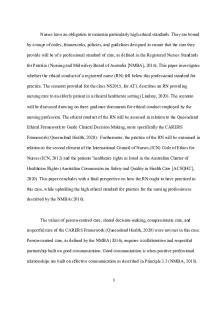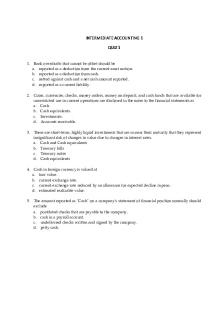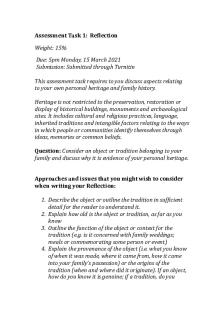Immunology Assessment Task 1 - Quiz PDF

| Title | Immunology Assessment Task 1 - Quiz |
|---|---|
| Author | melissa le |
| Course | Immunology 1 |
| Institution | University of Technology Sydney |
| Pages | 3 |
| File Size | 84.8 KB |
| File Type | |
| Total Downloads | 100 |
| Total Views | 134 |
Summary
Quiz 1 of Immunlogy from lecture one to three...
Description
Immunology Assessment Task 1 – Quiz 1 (Lecture 1 – Introduction, Lecture 2 – Innate Immunity 1, Lecture 3 – Innate Immunity 2) 1. Which complement pathway becomes activated by spontaneous hydrolysis of C3? Classical Alternative Lectin Both lectin and alternative 2. Which of the following statements is true for antimicrobial peptides (AMP)? Antimicrobial peptides enhance phagocytosis Antimicrobial peptides preferentially bind eukaryotic membranes Antimicrobial peptides include the cathelicidin and defensin families Antimicrobial peptides are negatively-charged short polypeptides 3. Which of the following TLRs are present inside innate immune cells? TLR3, TLR7 and TLR4 TLR9, TLR4 and TLR5 TLR6, TLR2 and TLR1 TLR3, TLR7 and TLR9 4. A complement component that is common to all complement pathways is… Mannose binding lectin (MBL) C3 C1q C1r 5. Which of the options below best completes the following statement: Innate immune cells rapidly recognise pathogen antigens… Directly via invariant (non-specific) receptors and /or antigen presentation Only after pathogen antigens are presented by an antigen presenting cell via specific receptors As part of the third line of defence that involves specific (acquired) immunity Only in secondary lymphoid organs, such as the lymph nodes, liver and spleen 6. Which of the option below best completes the following statement: A pH of 3-5 is ____ and ____ bacteria/fungi growth Acidic, enhances Acidic, inhibits Basic, enhances Basic, inhibits 7. Which of the options below best completes the following statement: Eosinophils …. Can function as an antigen presenting cell
Efficiently kill antibody-coated parasites Are detected in all vertebrates and are largely conserved for morphology and general function All answers are correct
8. Which of the innate immune cells below are not phagocytic? Lymphocytes Neutrophils Dendritic cells Macrophages 9. Which of the options below best completes the following statement: Interleukins are ….. Leukocyte secreted cytokines, which only act on B cells Are only produced in the bone marrow Only produced by T cells Leukocyte secreted cytokines, which act on leukocytes 10. Which of the following statements is false for Neutrophils? Neutrophils are phagocytes and granulocytes Neutrophils are usually the most abundant white blood cell (WBC) in peripheral blood Neutrophils are usually the least abundant white blood cell (WBC) in peripheral blood Neutrophils can produce reactive oxygen intermediates (ROI) 11. List 4 steps of phagocyte mobilisation and give an example of 1 phagocytic cell type that uses phagocyte mobilisation to enter into an inflamed area. Phagocyte Mobilisation 1. Leukocytosis: release of neutrophils from bone marrow in response to leukocytosis - inducing factors from injured cells 2. Margination: neutrophils cling to walls of capillaries in inflamed area in response to CAMs 3. Diapedesis of neutrophils 4. Chemotaxis: inflammatory chemicals (chemotactic agent) promote positive chemotaxis of neutrophils E.G. innate defenses -> internal defenses 1. Leukocytosis - neutrophils enter blood from bone marrow 2. Margination - neutrophils cling to capillary wall 3. Diapedesis - neutrophils flatten and squeeze out of capillaries 4. Chemotaxis - neutrophils follow chemical trail
12. Phagocytosis is a process whereby phagocytes can engulf pathogens. This process is comprised of 5 main steps List the 5 steps and include an example of a type of pathogen and what receptor it would bind to the phagocyte to initiate phagocytosis
Phagocytosis 1. Microbes bind to phagocyte receptors 2. Microbe is phagocytosed 3. Lysomes fuse with phagosome contain enzymes/oxidases pump free radicals into phagolysosome 4. Microbe is digested 5. Indigestible material is expelled E.G. Events of Phagocytes 1. Phagocyte adheres to pathogens or debris 2. Phagocyte forms pseudopods that eventually engulf the particles, forming a phagosome 3. Lysosome fuses with the phagocytic vesicle, forming a phagolysome 4. Lysosomal enzymes digest the particles, leaving a residual body 5. Exocytosis of the vesicle removes indigestible and residual material...
Similar Free PDFs

immunology quiz
- 9 Pages

BSBPMG522 Assessment Task 1
- 9 Pages

Assessment TASK 1 – Scenario
- 5 Pages

Assessment Task 1
- 2 Pages

Reflection Assessment Task 1
- 4 Pages

NS2015 Assessment Task 1
- 7 Pages

Assessment Task
- 3 Pages

Bsbcrt 412 - Assessment Task 1
- 5 Pages

Bsbcmm 511 - Assessment Task 1
- 14 Pages

Assessment 1 - Quiz
- 4 Pages

Immunology
- 36 Pages
Popular Institutions
- Tinajero National High School - Annex
- Politeknik Caltex Riau
- Yokohama City University
- SGT University
- University of Al-Qadisiyah
- Divine Word College of Vigan
- Techniek College Rotterdam
- Universidade de Santiago
- Universiti Teknologi MARA Cawangan Johor Kampus Pasir Gudang
- Poltekkes Kemenkes Yogyakarta
- Baguio City National High School
- Colegio san marcos
- preparatoria uno
- Centro de Bachillerato Tecnológico Industrial y de Servicios No. 107
- Dalian Maritime University
- Quang Trung Secondary School
- Colegio Tecnológico en Informática
- Corporación Regional de Educación Superior
- Grupo CEDVA
- Dar Al Uloom University
- Centro de Estudios Preuniversitarios de la Universidad Nacional de Ingeniería
- 上智大学
- Aakash International School, Nuna Majara
- San Felipe Neri Catholic School
- Kang Chiao International School - New Taipei City
- Misamis Occidental National High School
- Institución Educativa Escuela Normal Juan Ladrilleros
- Kolehiyo ng Pantukan
- Batanes State College
- Instituto Continental
- Sekolah Menengah Kejuruan Kesehatan Kaltara (Tarakan)
- Colegio de La Inmaculada Concepcion - Cebu




